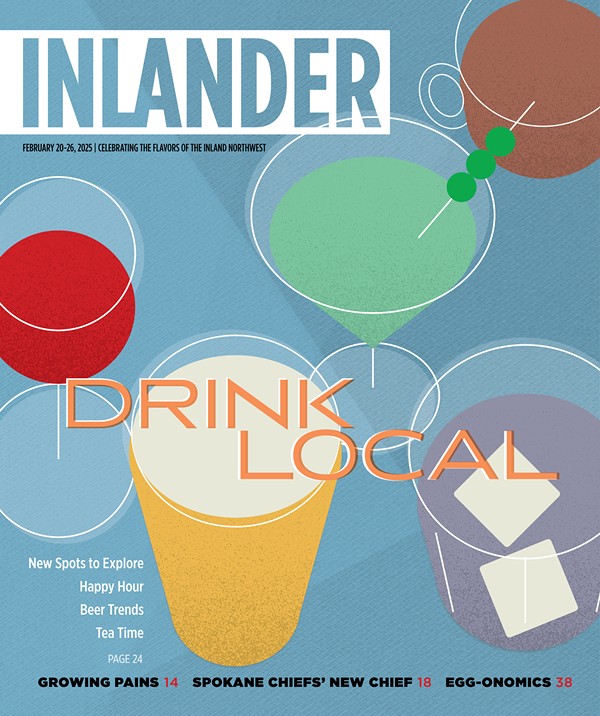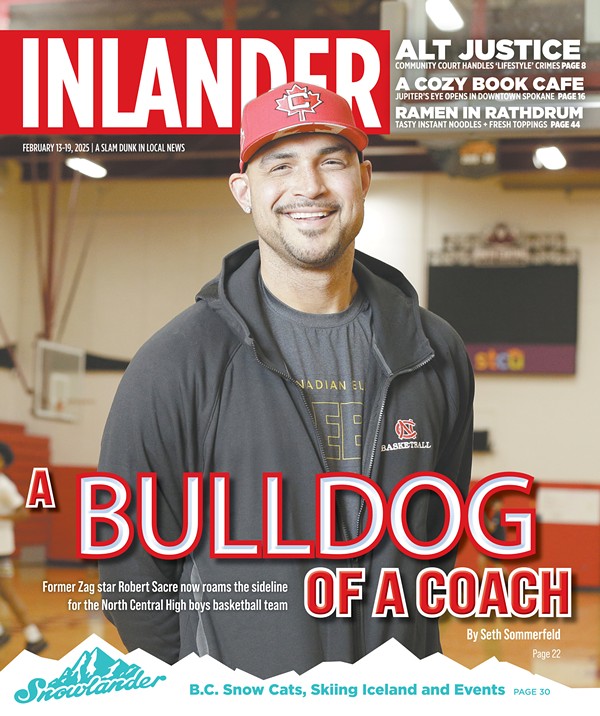Earl S. Frost, known as Jack, died on Sept. 10, 1943, in the Spokane County Courthouse. He was leaving the Auditor’s Office for home after a long day, like many long days before, when a heart attack caught him in the stairwell.
He’d been born a Texan, 47 years earlier, in a railroad boom town along the Red River. His mother died the day after his third birthday, and not a decade later his father was crushed between rail cars. So he was raised by his grandmother in a house of young uncles.
The first World War carried him to Alaska of all places, and to Spokane, where he met Miss Ruth Parrish and married her three months before Armistice. He worked his way through night school to become an accountant, and they raised four children on the north side of the growing Lilac City.
His death made front-page news in the Spokesman-Review, beneath headlines about Hitler and the Allied forces, and it was noted that he was “not only popular but an important figure in county affairs for the last 20 years.” It was also noted he left behind two daughters still living at home, the youngest of whom was my grandmother.
For a nation that takes pride in its self-made men, its immigrant dreams, its fresh starts and forward progress, we are fixated on delving into the past. And through the marvels of modern technology, it has never been easier to browse family history from the comfort of your couch.
Enthusiasts like to say that genealogy is the fastest-growing hobby in the United States. (Or second-fastest, in some versions.1) It’s also said, with a wink, that there’s only one thing searched more frequently on the web.
Tracking down family history used to mean typing out letters and sending them around the country, in hopes that some person or some municipality might have an answer. It meant traveling to courthouses in distant counties and walking through old family cemeteries.
After years of searching and social networking the old-fashioned way, genealogists were quick to realize the World Wide Web would change everything. These early-adopters congregated on rudimentary message boards, swapping facts and AOL email addresses.2 Now amateurs browse through millions of scanned documents, upload family photos and collaborate on shared family trees. Thousands of servers hum around the clock so we can stare, bleary-eyed, as great-great-grandmother’s birth certificate appears on the screen.
Of the thousands of sites devoted to family history, none rival the size or influence of Ancestry.com. What started as a website launched in 1996 by a small publishing company is now an empire of family history sites boasting a collection of 11 billion records, 2.5 million subscribers and 40 million searches every day.
Ancestry.com considers itself a technology company focused on family history, Vice President of Development Eric Zimmerman says, and its job boards are filled with positions that didn’t exist a generation ago: database managers, software engineers, UX designers, archival digitization specialists.
The next frontier moves the search from old records to the science lab with affordable DNA testing, available from Ancestry.com for just $99.
“This is a really exciting time in genealogy,” Zimmerman says.
The number of people investigating their own histories has increased with the ease, but the reasons have not changed: Some people chase romantic notions of castles in Scotland or rumored ties to celebrities. Some are curious about the family stories they’ve heard over and over; others about the ones never told. For the Church of Jesus Christ of Latter-Day Saints — a longtime leader in family history research — it’s driven by the belief that our ancestors are bonded to us forever and want us to find them.3
But the most immediate reason, the one that comes up more than any other, is a death in the family. Maybe a box of documents was found, or an album of photos. A question remains, and there is no one to ask.
1. Dick Eastman, the founder of the popular Online Genealogy Newsletter, wrote about the “second-fastest growing” claim and asked readers if anyone knew where it originated. I wrote to him asking whether he ever found a satisfying answer, and he says no: “I have read and heard lots of claims, but none of them (since the mid 1990s) could ever be traced back to an unbiased and statistically correct source.”
2. A 1999 cover story in TIME called these new methods “cyberrooting.”
3. The Mormon church funds one of the most popular websites, FamilySearch, which draws from the vast collection of the Family History Library in Salt Lake City. More than 4,000 Family History Centers are open to the public worldwide, typically in stake centers, for free access to all the major genealogy sites and other materials. It’s not a trap; they won’t send missionaries to your house uninvited. The FamilySearch site puts it this way: “Our commitment to helping people connect with their ancestors is rooted in our beliefs — that families are meant to be central to our lives and that family relationships are intended to continue beyond this life.”
At Eastern Washington Genealogical Society’s spring seminar, guest speaker Mike McKinnon is speaking to a full conference room about tips for better Google searching. The audience could be mistaken for a reunion of retired teachers, and they take notes on legal pads and smartphones as McKinnon shows the audience how to use search operators and how to avoid porn when you search a woman’s name in Google Images.4
And then he demonstrates how Google Street View lets him zoom to the small Irish town where some of his ancestors once lived, and walk around as if he were visiting.
“And I am now in Ireland,” he says.
Oh my goodness. A wave of gasps and murmurs fills the room.
Most of the society members were born long before computers became part of our everyday life — some can find themselves on the 1940 census, released last year — but much of what the society does now is directly related to digital: Classes are held in the library’s computer lab every month, small groups are based on preferred family tree software and presentations take on topics like adjusting to life without Google Reader. The society’s blog just got named one of Family Tree Magazine’s Top 40 Genealogy Blogs of 2013.
But they’ve been doing this a long time, and they know the Internet doesn’t have all the answers. Not yet, probably not ever.
Up on the third floor of the downtown library, the family history shelves hold thousands of volumes — city directories, land records, surname histories, multi-volume indexes — that belong to the society but have been housed at the library for decades. The society has accumulated some 5,600 items since it was founded in 1935, and some of the oldest books reflect the roots of early members who donated their personal collections.
Near the books, the only card catalog left in the library contains the work of Lee Patchen, who started indexing the collection in 1948. For years and years, he clipped out obituaries from the local papers and pasted each one on its own card with the name, the date and the paper. By the time he died in 1970, he had made about 200,000 cards.
“The Internet is just the tip of the iceberg when it comes to resources,” says Miriam Robbins, who, in her 40s, is one of the younger members of the group. “There are so many things in repositories and archives that aren’t digitized or microfilmed, and never will be.”
Robbins teaches seminars and classes on using the Internet as a research tool, but she first got interested in genealogy before that was an option. Her grandmother was adopted and had found the names of her biological parents in some guardianship papers. Robbins researched the names, found the mother’s living relatives and was able to reunite her grandmother with them after more than half a century.
Robbins says she feels fortunate that she learned to research the old way, because now she sees two distinct groups: Older people who aren’t taking advantage of everything that’s on the web, and younger people who assume they can find everything there.
“There’s this disconnect between people who’ve been doing it the old way and people who are doing it the new way — and they need each other, they really do.”
4. Google’s SafeSearch feature is something I hadn’t known about before, and I consider myself a fairly advanced Google user. Another of the more fascinating tips from McKinnon’s presentation is that you can search for similar images by dragging an image from your desktop into the search bar.
My great-great-great grandmother Mollie R. Peach was 19 when she got married to Sevier Frost on Christmas Day 1869, in Barry County, Missouri. She was widowed at 31, with six young children and another on the way.
The railroad was expanding south into Texas at that time, and by 1890 the family settled in Denison, Texas, a bustling hub where the MKT Railroad — called the “Katy” — intersected with the Red River. Denison was called “The Gateway to Texas” and “Katy’s Baby.” Its proud founders built an opera house, a handsome brick public school and, at five stories, the tallest skyscraper in all of Texas. Main Street wasn’t paved, but it was built wide to accommodate big plans.5
Mollie’s sons went to work for the railroad.
Her second son, Hardy Late Frost, fell for a Texan girl as pale and delicate as a porcelain doll. Her name was Ethel Groom, and she wasn’t yet 18 when they got married in 1895. The first grandson arrived the following year: baby Earl, named for his uncle Early.
H.L. and Ethel Frost (left); detail from an 1891 map of Denison, Texas (right).
Then times got harder. Ethel died without seeing the new century, the day after her only son’s third birthday. The boy was in the fifth grade at the city’s public school when the family received news that the railroad had claimed the first of Mollie’s sons. The brief newspaper account at the time said Hardy Late Frost “was killed in the yards at Mena, Ark., Wednesday night.” The train carried his body home.
The family put a notice in the paper a few weeks later: 6
“We wish to thank our friends and neighbors, and especially the O.R.C. lodges 7 at Mena, Ark., and Denison, Tex., for their kindness and many acts of sympathy during our great bereavement in the loss of our son and brother, H.L. Frost.
Mrs. M. R. Frost, Brothers and sisters and little son Earl.”
5. Denison is now best-known as the birthplace of President Eisenhower, who was born there in 1890.
6. The Library of Congress has one of the finest collections of historic newspaper available online, called Chronicling America. But this was from a rarer find: The University of North Texas Libraries has a collection of 124 issues of The Denison Herald that are scanned and fully searchable online. It was pure luck that the time range of 1906-1907 happens to cover Hardy Late Frost’s death.
7. Order of Railway Conductors, a fraternal union founded in 1868.
The first rule of genealogy for beginners: Use pencil.
Out at the Spokane West Stake Center for the FamilySearch Symposium, genealogical society president Donna Potter Phillips begins the day of seminars with a lighthearted but cautionary tale about collecting heart-shaped rocks with her daughter. It’s easy to find a rock that looks sort of like a heart, she tells the group, and easy to convince yourself that it’s close enough — and that’s the moral.
“Make sure you gather into your bag only persons who are your ancestors,” she cautions. “No making them fit.”
Some of those who’ve watched amateur genealogy evolve are concerned that sites like Ancestry.com may be overplaying the ease of discovering true roots.8 The broad search and suggested connections make sure people find something, but not always the right thing.
Tracing family history may be easier than ever, but that doesn’t make it easy. Documents have mistakes, county names and boundaries change,9 and whole collections of records are lost. The vast majority of the 1890 census was destroyed in a 1921 fire at the Commerce Building in Washington, D.C., leaving a two-decade gap right during the Industrial Revolution time when Americans were on the move.10 At least 16 million military personnel records held in St. Louis, Mo. — including most of the Army records for both World Wars — were lost in a 1973 fire that blazed uncontrolled for almost an entire day.
And then our ancestors don’t always help, either. Three generations of Williams marry Elizabeths, or five cousins with the same name all grow up together in the same town. Our ancestors went by their initials, or their middle names, or spelled their own names differently at different times.11 Divorced women were often recorded as widowed. Adult children guessed where their own parents were born. Imagine a census recorder stopping by a farmhouse in the 1800s — depending on who answers the door, the answers might be very different.
The reunion with ancestors is not always as we imagine. Once a woman from out of state stopped by the downtown library while visiting Spokane. Her family had always spoken of a relative who lived in a Spokane, a prominent early businesswoman, and she wanted to see if there were any truth in it. Sure enough, it turns out the relative was quite well-known — especially to police, as a rather successful brothel madam.
The facts of the past are not always kind ones. Our family trees bear slaves and slaveowners, cowards and criminals, murderers and victims. Our ancestors were praised for killing Indians, and disowned for getting divorced. Our families covered up homosexuality and mental illness, and the documents sometimes tell very different stories than our relatives do.
Often what you find is merely the bones — a birth date, a place, a cemetery record. It’s much harder to find the sinew of history — the whys, the hows, the connections that turn a few names and dates into a full life story.
It’s sometimes put this way: On a headstone you will find two dates, the beginning of the life and the end of it, with a dash in between. As the basic vital facts become easier to track down, more people are trying to understand the dash.
8. Some subject lines of emails I received from Ancestry.com after signing up for the free two-week trial: “Add Grandpa and Grandma to your tree, Lisa,” “Don’t miss out on your family story,” “Lisa, the 1930’s may be the key to your past.”
9. Spokane County, for example, extended far beyond its current boundaries when it was created in 1858. It then ceased to exist altogether for about 15 years after the newly formed Stevens County absorbed it in 1864.
10. The 1921 fire was a turning point for political support of a National Archives building in Washington, D.C. Congress approved the building in 1926 and construction started in 1931. Not all the records are kept there; the National Archives and Records Administration has a number of facilities around the nation.
11. Mollie R. Peach was my first minor brick wall. As an adult her name was recorded as Mollie, Mary, Martha and her initials. But as a child she was recorded in the census as Rebecca, since her given name was probably either Mary Rebecca or Rebecca Mary.
At the edge of the Eastern Washington University campus in Cheney, a state-of-the-art building holds the region’s history.
On the first floor, the Eastern Branch of the Washington State Archives cares for the past. The sweet scent of old paper lingers in the cool, climate-controlled stacks, where heavy leather-bound volumes fill the beige shelves with original records of marriages, deeds and prison fines.
Assistant Archivist Lee Pierce at the Eastern Regional Branch of the Washington State Archives, located in Cheney. Young Kwak photo
The second floor houses a less traditional repository — the nation’s first-ever state digital archives. The space feels halfway like a library and half like a tech startup loft, with standing desks for the programmers and a pingpong table outside the fireproof data vault. One room is full of archaic computers, cassette players and early Macs — partly as a functional hardware library in case an old file surfaces that’s not compatible with modern computers, and partly because it’s awesome. Network Administrator Harold Stoehr says that room is a tour-group favorite.
“People will run up to some old computer like it’s an old friend,” he says.
Farther back, lights blink and spinning discs act as the digital equivalent of archive assistants searching for materials in the stacks downstairs. An adjacent room contains an elaborate system for backup power, and multiple backups of the 55-terabyte database are kept in the reinforced, fireproof vault. The people of Washington can rest assured their data is prepared for the worst.
The digital archives were built from the traditional model, with lockers for researchers’ things and a reading area just like downstairs. But pretty much no one came by — aside from some EWU students who realized it was a quiet place to study for finals — and why would they when it’s all online?
The primary mission of the digital archives is to capture state and local records that are “born digital” — audio recordings, governors’ emails, snapshots of agencies’ websites. But through statewide projects to image and index historic records kept in the five regional archives, the website has also become a portal for searching a vast number of Washington documents.
“The demand is to have things online,” says Steve Excell, the state archivist in Olympia.
Occasionally they still get longhand letters, and some people still drive to the archives in Olympia to sift through original documents in the reading room, but most people don’t want to do that — they want to sit at home on a rainy weekend and poke around in the archives on their own time.
They started with the marriage records, because each one matters to two families.12 The eastern branch finished so quickly that King County shipped over 700,000 marriage records, dating from 1855 to 1990, in a secured state archives truck. The original records were sent back just as carefully, but by then each one also existed as a digital file intended to live online forever.
They’ve since moved on to birth, death and naturalization records, though the pace slowed as the budget got tighter.13 The state archives staff is half of what it was five years ago.
And the mission of preserving public records is harder than ever before. Paper endures better than electronic records; we rely on computers for everything, but we still treat paper with more significance. Excell, the archivist, calls digital records “fragile.”
“When it went electronic,” he says, “we had to compete with the delete key.”
12. I have parents, grandparents, great-grandparents and great-great-grandparents who all got married in the state of Washington. Finding and downloading images of all their marriage certificates from the Washington State Digital Archives site takes about five minutes.
13. The Washington State Archives is funded by recording fees, so the economic downturn had a direct effect on funding.
It’s said that my great-great-great-great-grandmother, Amelia Lonesome Patterson, had 24 children, though there is proof of only 17: Micajah, Elijah, William English, Thomas Simpson, Matthew, Nancy Ann, Mary Adeline, Elizabeth, Rhoda, Sevier, White, Snow, Winter, Young, Sarah and Hiram Joseph. Besides her own children, it’s said she was a midwife who helped bring every child in the county into the world.
Amelia and her husband, Elijah Frost, were both born on the frontier side of the mountains in eastern Tennessee in the years after the Indian Wars, when that land was still Cherokee territory. Elijah’s father, Micajah Frost, had come from Virginia with his father and brother after the Revolutionary War,14 and settled on a piece of land set between two ridges along Poplar Creek right about the time Tennessee became the 16th state of the union in 1796. It’s said they were the first white settlers in the area.
A few Frosts stayed put long enough to be buried in Tennessee, but most of the sons and grandsons kept moving west, pushing the frontier clear out to the Pacific Coast. One went by wagon, crossed the mountains six times, then settled outside Boise.15 One was shot and killed in the streets of a California town.16 Some fought in the Civil War, some homesteaded in Missouri and some left Oklahoma during the Great Depression.
The place where Micajah Frost laid claim to land is still called Frost Bottom, but no Frosts live there anymore.
What will happen to our Facebook pages? Will our grandchildren read our Twitter feeds?
The criminals and the congressmen get their place in history books; the governor’s emails will be archived. But what about ordinary folks — the ones who get up each day, go to work, hug their families, pay their bills?
We say our lives have never been so documented, but what will endure? We don’t write letters. We’re not listed in phone books. Federal census questions now are purely statistical — it no longer will say where we were born, or where our parents were born, or what our occupations were.
In some ways digital records are more like oral history, says web historian Marc Weber — the files must be copied and updated regularly to keep them from disappearing. Unlike paper documents tucked away in attics or clay tablets buried in natural disasters, digital records will not survive by accident.
In 50 years, institutions will have a system for preserving digital records, Weber says. But we haven’t adapted yet, and we don’t know whether big companies like Google and Facebook will make a point to preserve the data we feed them. Our generation could leave behind an unprecedented record of everyday life, or we could see our digital lives abandoned and lost.
“It really could go either way,” Weber says.
14. A century after Micajah died an old man, descendants typed neat letters to the Veterans Administration asking for any information that might be in his records. They all received the same typed response with details of his military service. But — “There are no data in regard to the soldier’s family.” These letters are now scanned and available online; I found them on Fold3, the Ancestry.com site that specializes in military records.
15. This was Sevier Frost’s older brother, Elijah S. Frost, who eventually settled near Boise in Caldwell. While living in Ada County, Idaho, he and his wife had two daughters named Ada and Ida.
16. This was a grandson of Micajah Frost’s brother Elijah. His family had a longstanding feud with the Coates family that is recounted, with varying details, in a number of books on California history.
In 1943, when Earl S. Frost died in the stairwell of the county courthouse, the courtyard on the north side of the building had not yet been filled in. On that September evening, light would still have been coming through the five tall windows at every stair landing.
If you look closely, you can see the outlines where those windows still exist inside the wall. Spokane County Auditor Vicky Dalton and facilities manager Ron Oscarson, guardians of courthouse history, point it out as they guide me through the building.
Family photos of Earl S. Frost with his children.
I had called Dalton earlier that day with an admittedly odd request and sent her the two Spokesman-Review articles about my great-grandfather: the report from the morning after he died, and a short feature from a decade earlier that explains his job duties and pictures him sitting behind his desk.17
In her office within the Auditor’s Office on the second floor, she shows me reports from the early years, bound together in green volumes and stamped on the cover with “Not To Be Taken From County Auditor’s Office.” Dalton hopes to have the books imaged at some point, but for now they reside in a glass-fronted bookcase near the door to her office with every other annual report published since the 1890s.
The 1929 report is the first with his name listed — Jack Frost, Chief Accountant — and the last is 1942. I turn the pages and try to imagine the man whose life’s work is printed in these columns of numbers.
“You’re touching what he handled, what he touched,” Dalton tells me.
For a couple of years starting with the 1943 report there are occasional pencil marks beneath the published sums and figures — those corrections suggest he was a hard man to replace, she says.
In another book she turns to a floor plan of the building at that time, and points to the little typed label spelling out ACCOUNTING in one of the turret offices — the same turret office we are in now.
I look around at the curved wall and windows overlooking Broadway Avenue. Dalton and Oscarson point out the radiator in the newspaper photograph, and there it is below the window. They point out the hand-painted wainscoting in the photo, which still exists in an office down the hall.
Oscarson points out that there are only two things that separate us from history: time and space. And when you hold the same things they held, or sit in the same place they sat — it’s only time.
And then I walk down the stairs Earl S. Frost walked down, day after day, until his last.
17. I initially found these stories in the Patchen file, the genealogical society’s obituary card catalog at the library. The card for my great-grandfather, Earl S. Frost, has handwritten dates and page numbers for these two articles. I looked up the articles on microfilm at the library — which was, honestly, a huge pain — and then realized I could look them up far more easily on Google News Archive.

























